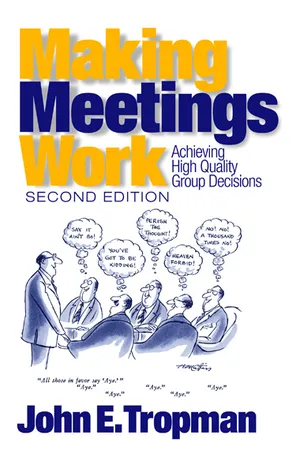
- 256 pages
- English
- PDF
- Available on iOS & Android
About this book
A best-seller in its first edition, Making Meetings Work: Achieving High Quality Group Decisions, Second Edition covers everything you need to know about organizing engaging meetings, including preparing agendas, controlling what happens behind the scenes prior to and after meetings, and managing conflicting values and personalities. Through the Meeting Masters Research Project at the University of Michigan, author John E. Tropman observed and interviewed the nation?s most successful meeting experts to find out how to make meetings both stimulating and productive. Based on his findings, Tropman formulated seven principles and fourteen commandments for implementing dynamic meetings.
This second edition has been extensively revised and expanded to include
- Family meetings and family group decision making
- Problems and solutions for board of directors meetings
- Community and civic meetings
- Volunteers and meetings
- Leadership in community decision making
Making Meetings Work: Achieving High Quality Group Decisions, Second Edition provides simple, easily applied best practices for supervising or instigating meetings with decision accomplishment outcomes. Author John E. Tropman reveals goal oriented procedures that keep proposals moving towards quality group decision making and assure other participants look forward to attending your meetings.
Written with humor and a deep understanding of the realities of business and political life, Making Meetings Work: Achieving High Quality Group Decisions, Second Edition is an extraordinary resource for anyone who leads, facilitates, or attends meetings.
Frequently asked questions
- Essential is ideal for learners and professionals who enjoy exploring a wide range of subjects. Access the Essential Library with 800,000+ trusted titles and best-sellers across business, personal growth, and the humanities. Includes unlimited reading time and Standard Read Aloud voice.
- Complete: Perfect for advanced learners and researchers needing full, unrestricted access. Unlock 1.4M+ books across hundreds of subjects, including academic and specialized titles. The Complete Plan also includes advanced features like Premium Read Aloud and Research Assistant.
Please note we cannot support devices running on iOS 13 and Android 7 or earlier. Learn more about using the app.
Information
Table of contents
- Cover
- Contents
- Acknowledgments
- Introduction
- Part I - Paradigm Shift: The Self-Fulfilling Prophecy
- Chapter 1 - Principle Driven: The Seven Imperatives
- Part II - Managing for Meeting Success
- Chapter 2 - Managing Agenda Organization
- Chapter 3 - Managing Agenda Design: The Rule of the Agenda Bell
- Chapter 4 - Managing Meeting Text: The Writing Rules
- Chapter 5 - Managing Participant Trust: The Integrity Rules
- Chapter 6 - Managing Pre-meeting and Post-meeting Tasks
- Chapter 7 - Managing Rehearsals, Performances, and Audiences
- Chapter 8 - Managing Emotional Elements of Meetings
- Chapter 9 - Managing the Flow of Ideas and Proposals: Dealing With Difficulties in Idea Processing
- Chapter 10 - Managing Bases for Decisions in Meetings: The Decision Rules
- Chapter 11 - Managing Decision and Choice
- Chapter 12 - Managing Positions and Roles in Meetings
- Chapter 13 - Managing Tasks and Functions in Meetings
- Chapter 14 - Managing Conflicting Values in Meetings
- Chapter 15 - Managing the Evaluation Rules
- Part III - Becoming a Meeting Master: Some Tips on Application
- Chapter 16 - Strategies and Tactics of the Meeting Masters
- Chapter 17 - Implementing Total Quality Meetings (TQM)
- Part IV - Strategic Perspectives on Meetings
- Chapter 18 - The Meeting: Lore and Legend
- Chapter 19 - The Negative Culture of Meetings
- Chapter 20 - But Why Do Things Go Wrong?
- Chapter 21 - Quality Management Equals Quality Decisions
- Part V - Leadership in Family Meeting and Civic/Community Meeting Decision Making
- Chapter 22 - Family Group Decision Making and the Family Meeting
- Chapter 23 - The Eclipse of Community and the Civic Meeting: From Bowling Alone to Meeting Alone
- Chapter 24 - Crisis in Governance: Problems With Boards of Directors
- Chapter 25 - Leadership in Community Decision Making
- Appendix A: Writing Samples
- Appendix B: Sample Evaluation Sheet
- References
- Bibliography
- Print References
- Index
- About the Author